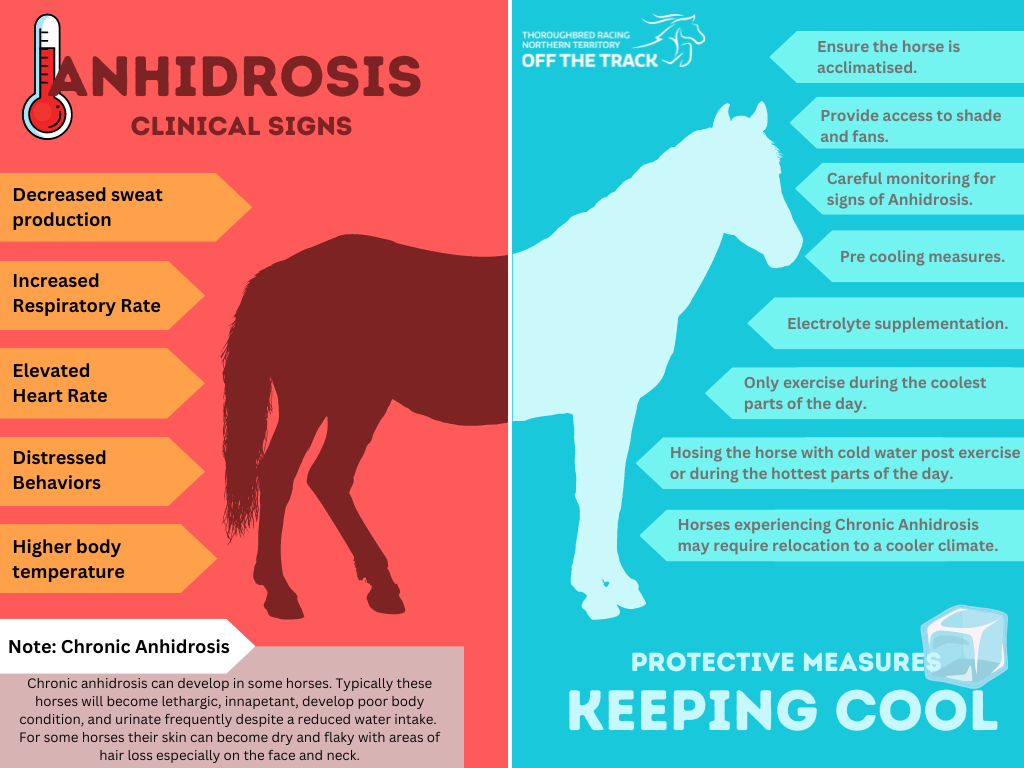- Home
- Off The Track
- Educational Content
- Understanding Anhidrosis
Understanding Anhidrosis

What is Anhidrosis?
Anhidrosis is the inability to sweat adequately resulting in impaired thermoregulation. Horses lose 70% of their body heat through sweating, so it is a significant issue and typically occurs in hot humid conditions such as in the top end, though it can occur in more temperate climates especially during heat waves.
The condition affects horses of all age groups, breeds, coat colours, genders and activities. It occurs just as commonly in introduced horses as locally bred horses.
What are the clinical signs?
There are degrees of anhidrosis, with various degrees of clinical signs which often progress. Clinical signs can occur acutely or gradually.
- Sweating- Initially horses sweat profusely and for many hours after exercise, then they lose the ability to sweat in areas especially in skin closely adherent to the underlying tissue-rump, back of the thigh and back of the rib cage. This normally progresses to more areas though complete anhidrosis is rare. Typically, we see horses after strenuous exercise isolated sweating under the mane, saddle, axillary, inguinal and perineal region.
- Increased respiratory rate (RR) as horses try to lose heat by the more inefficient respiratory system. Normal RR at rest is less than 12, but can increase to 100 bpm after exercise and persist.
- Signs of overheating- distressed, high and persistent RR, high heart rate (normal 40 bpm- elevated to over 100 and more), high blood pressure, high rectal temp (normal 37-38’C- can increase to 41’C and more). Horses can have dilated blood vessels and hot skin without any sweating. Death can result if forced to exercise as the result of cardiac failure.
- Chronic anhidrotic horses typically are lethargic, innapetant, have poor body condition, urinate frequently though can have reduced water intake. Some horses the skin can become dry and flaky with areas of hair loss especially on the face and neck.
What causes it?
We do not know. It is a complex condition affected by the endocrine and neurological system on the sweat glands.
The condition can be aggravated by factors that tend to increase basal metabolism (high protein or energy feed, disease, exercise), that exacerbate water loss (polyuria- increased urination) or that influence heat loss and help to dislocate body heat control.
Risk factors include high humidity, poor heat acclimitisation, minimal daily temp above 23’C, arsenic based tonics, electrolyte (Sodium, chloride and Potassium) and vitamin deficiency, endocrine excess/deficiency of the thyroid and adrenal cortical axis, genetics, intensive work and /or training, nervous temperament and systemic infection.
In temperate and subtropical climates, there is partial recovery of the ability to sweat during winter; however, the degree of recovery becomes progressively less with each ensuing year. Before settling into a permanently anhidrotic state, some horses go through one or more short cycles of sudden onset anhidrosis followed by spontaneous recovery. It should be noted that such horses are rarely cured of anhidrosis and generally stop sweating within 2–3 months of return to hot, humid conditions.
Can horses be treated for Anhidrosis?
Unfortunately, there is no magical cure. There is no reported treatment for anhidrosis that passes even the lowest standard for evidence-based medicine
Management recommendations
Affected horses must be kept from becoming hyperthermic, especially during hot conditions. As a result, protective cooling measures should be adopted into husbandry practices for horses housed within tropical climates. The following examples are beneficial to keeping horses cool:
- Ensure that housing provides the horse with access to shade.
- The installation of fans within stables.
- The time of exercise should be considered. Whilst early mornings are cool, there is often a high level of humidity. This should be considered in comparison of the later afternoons to evenings, which are often lower in humidity levels.
- Horses should not be exercised beyond their level of fitness under any environmental conditions. Additionally, owners should be mindful that the horse will warm up faster and tire more rapidly during hot weather.
- Pre-cooling measures can be adopted, by briefly hosing the horse before exercising.
- Water and electrolytes should be provided free choice.
- Hosing the horse during the hottest parts of the day.
- Ensure the horse is acclimatized to the weather conditions.
- The amount of concentrate fed should be calibrated to exercise requirements and cut back during periods of inactivity.
- Carefully monitoring the horse for any clinical or behavioral signs which may indicate Anhidrosis.
In combination with the above techniques, aggressive cooling measures should be introduced post exercise where the horse may be demonstrating signs of heat stress (i.e., excessive panting, hot to touch, distressed behaviors). The following techniques are considered beneficial for rapid cooling:
- Continuous hosing with cold tap water
- Tipping buckets of ice water over the horse
- Keeping the horse under fans and shade
- Ensuring the horse has access to water and electrolytes
The horse’s tolerance to heat is subjective, whilst management techniques may work hard to support the horse’s welfare by keeping them as cool as possible within the climate. Unfortunately, some horses will still develop Chronic Anhidrosis which can’t be managed at level supportive of their welfare. This will be noticeable as their performance in compromised, along with their general well-being and condition. In these instances, the best option will likely require the horse’s relocation to a cooler climate.
Attached below are some recommended resources that include further information regarding both Anhidrosis and different cooling methods:
FEI Optimising Performance in a Challenging Climate:https://inside.fei.org/sites/default/files/Session_6_Optimising_performance_in_a_challenging_climate_SUPPORTING_DOC.pdf
Anhidrosis in Horses What Do We Know?: https://edis.ifas.ufl.edu/pdf/AN/AN36200.pdf

